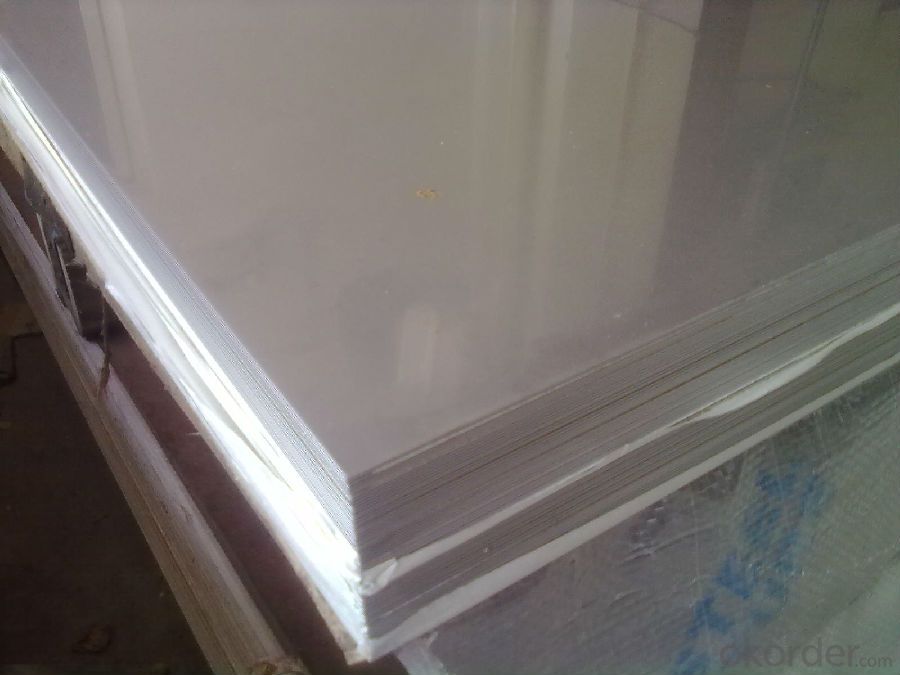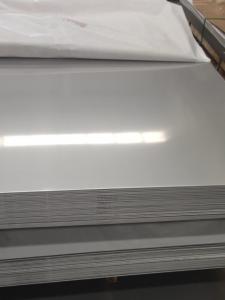Stainless Steel sheet and plate with Amazing discount
- Loading Port:
- Shanghai
- Payment Terms:
- TT OR LC
- Min Order Qty:
- 10000 m.t.
- Supply Capability:
- 5000000 m.t./month
OKorder Service Pledge
OKorder Financial Service
You Might Also Like
Specifications of stainless steel
304 stainless Steel Plate
stainless steel plate,steel sheet,steel plate
Standard: ASTM,GB,DIN,JIS,ISO,EN,etc.
TISCO stainless Steel Plate 304/NO.1 finished
stainless steel plate,steel sheet,steel plate
Standard: ASTM,GB,DIN,JIS,ISO,EN,etc.
Delivery short and low cost advantage.
Description of stainless steel:
stainless steel plate,hot rolled stainless steel plate,cold rolled stainless steel plate,stainless steel sheet,steel sheet,sheet






Material of stainless steel:
304,304L,309S,310S,316,316L,316Ti,317L,317L,321,347H,409,409L,410S,420,430,201,202,etc.
Thickness of stainless steel:
From 0.3mm to 100mm
Width of stainless steel:
1000mm,1219mm,1250mm,1500mm,1800mm,2200mm,2500mm or as your requirement
Length of stainless steel:
2000mm,2438mm,2500mm,6000mm,6096mm or as your requirement
Application of stainless steel:
Stainless steel plate applies to construction field, ships building industry, petroleum & chemical industries, war and electricity industries, food processing and medical industry, boiler heat exchanger, machinery and hardware fields. Our company has cooperative relation between the domestic agents. Stainless steel plate can be made accordingto the customers requirements. Fasten delivery. Quality assured.Welcome to order more.
Contacts
If you have any question,please feel free to contact us.
- Q: Can stainless steel sheets be used for decorative purposes?
- Certainly, decorative purposes can be served by stainless steel sheets. Renowned for its sleek and contemporary look, stainless steel is a widely preferred option for diverse decorative uses. Its applications span across interior design, architecture, and even art installations. Stainless steel sheets can be personalized to fashion distinctive patterns, textures, and finishes, rendering them ideal for crafting captivating and visually enticing decorative elements. Moreover, stainless steel boasts exceptional durability, corrosion resistance, and simple maintenance, making it a pragmatic choice for both indoor and outdoor decorative applications.
- Q: Can stainless steel sheets be used for storage containers?
- Yes, stainless steel sheets can be used for storage containers. Stainless steel is a durable and corrosion-resistant material that is commonly used in various industries, including food and beverage, pharmaceuticals, and chemical storage. Its ability to withstand high temperatures, resist rust and stains, and its non-reactive nature make it an ideal material for storage containers. Stainless steel sheets can be fabricated into containers of various sizes and shapes, providing a secure and hygienic storage solution for a wide range of products. Additionally, stainless steel is easy to clean and maintain, ensuring the longevity and cleanliness of the storage containers.
- Q: What is the maximum thickness of a stainless steel sheet?
- The maximum thickness of a stainless steel sheet can vary depending on the specific grade or type of stainless steel being used. In general, stainless steel sheets can range from as thin as 0.4 millimeters (0.0157 inches) to as thick as 100 millimeters (3.937 inches) or more. However, it is important to note that the availability of thicker sheets may be limited and can vary based on the supplier or manufacturer. Additionally, some stainless steel alloys may have different thickness limits due to their composition and intended use. Therefore, it is always recommended to consult with a supplier or refer to the specifications provided by the manufacturer to determine the maximum thickness of the specific stainless steel sheet you require.
- Q: Are stainless steel sheets available in different finishes?
- Yes, stainless steel sheets are available in different finishes. Stainless steel is a versatile material that can be finished in various ways to achieve different appearances and textures. Some common finishes include brushed, mirror, satin, and textured finishes. Each finish has its unique aesthetic appeal and can be chosen based on the desired look and application requirements. The choice of finish can also impact the stainless steel sheets' resistance to corrosion, staining, and scratching. Therefore, manufacturers offer a variety of finishes to cater to different customer preferences and specific project needs.
- Q: What is the maximum size available for stainless steel sheets?
- The maximum size available for stainless steel sheets can vary depending on the manufacturer and supplier. However, commonly available sizes range from 4 feet by 8 feet (1220mm by 2440mm) to 5 feet by 10 feet (1524mm by 3048mm).
- Q: Are stainless steel sheets resistant to scaling?
- Stainless steel sheets possess resistance against scaling. Scaling is the result of oxide layer formation on a material's surface when subjected to elevated temperatures. Stainless steel comprises a significant amount of chromium, which generates a protective chromium oxide layer when exposed to oxygen. This oxide layer acts as a barrier, halting any further oxidation or scaling of the stainless steel. In addition, the inclusion of alloying elements like nickel and molybdenum further strengthens the scaling resistance of stainless steel sheets. Consequently, stainless steel sheets exhibit a high degree of scaling resistance, rendering them suitable for utilization in high-temperature surroundings.
- Q: How do you remove water stains from stainless steel sheets?
- In order to eliminate water stains from stainless steel sheets, the following steps can be followed: 1. Commence by using a soft, damp cloth to wipe the surface of the stainless steel sheet, removing any loose dirt or debris. 2. Combine warm water and mild dish soap in a bucket or bowl to create a solution. Immerse a clean cloth in the soapy water and squeeze out any excess liquid. 3. Delicately rub the cloth over the water stains on the stainless steel sheet, ensuring to follow the grain of the stainless steel to prevent further damage or scratching. 4. For more stubborn water stains, a non-abrasive cleaner specifically designed for stainless steel can be utilized. Apply a small amount of the cleaner to a clean cloth and gently rub it onto the stained areas. 5. Rinse the stainless steel sheet with clean water to eliminate any soap residue. Utilize a separate clean cloth or sponge to wipe away any remaining water. 6. To prevent future water stains, a stainless steel cleaner or polish can be applied to the surface. Follow the instructions on the product label for optimal results. Always remember to test any cleaning solution or product on a small, inconspicuous area of the stainless steel sheet before applying it to the entire surface. This will ensure that the cleaner or polish does not cause any damage or discoloration.
- Q: What are the applications of stainless steel sheets in the automotive industry?
- Stainless steel sheets in the automotive industry are used for various applications such as body panels, exhaust systems, fuel tanks, and structural components. They provide excellent corrosion resistance, high strength, and durability, making them ideal for withstanding harsh conditions and ensuring long-lasting performance in vehicles. Additionally, stainless steel sheets can be easily formed and welded, allowing for precise shaping and customization according to the specific requirements of different automotive parts.
- Q: What are the common sizes and thicknesses of stainless steel sheets?
- The sizes and thicknesses of stainless steel sheets vary depending on their intended use and industry standards. However, there are standard sizes and thicknesses commonly found in the market. Stainless steel sheets are commonly available in sizes ranging from 4x8 feet (1219x2438mm) to 5x10 feet (1524x3048mm). These sizes are widely used in construction, automotive, and fabrication applications. In terms of thickness, stainless steel sheets come in a range of gauges, typically measured in inches or millimeters. The most frequently used thicknesses are 0.0276 inches (0.7mm), 0.0359 inches (0.91mm), 0.0478 inches (1.21mm), 0.0598 inches (1.52mm), 0.0747 inches (1.90mm), and 0.0897 inches (2.28mm). These thicknesses find frequent application in commercial and industrial settings. It is important to note that stainless steel sheets can be customized to meet specific requirements, encompassing non-standard sizes and thicknesses. In such instances, it is advisable to seek guidance from a supplier or manufacturer who can offer tailored solutions based on the project's unique needs.
- Q: What are the advantages of using stainless steel sheets in the aerospace industry?
- There are several advantages of using stainless steel sheets in the aerospace industry. Firstly, stainless steel is known for its exceptional strength and durability. It can withstand high temperatures and extreme conditions, making it ideal for aircraft components that require superior performance and longevity. This strength allows stainless steel sheets to resist corrosion, which is crucial in an industry where safety is of utmost importance. Secondly, stainless steel sheets offer excellent resistance to impact and fatigue. This is particularly vital in the aerospace industry, where components are subjected to constant vibrations and stress. Stainless steel can absorb these forces without compromising its structural integrity, ensuring the safety and reliability of the aircraft. Thirdly, stainless steel sheets have a high strength-to-weight ratio, making them lightweight yet strong. This is crucial in aviation, where reducing weight is a primary concern for fuel efficiency and overall performance. By using stainless steel sheets, aircraft manufacturers can achieve the desired strength without adding unnecessary weight, contributing to improved fuel economy and increased payload capacity. Furthermore, stainless steel sheets are highly versatile. They can be easily formed, welded, and machined into complex shapes and sizes, allowing for the production of intricate aerospace components. This versatility enables engineers to design and manufacture innovative aircraft parts, leading to improved aerodynamics, reduced drag, and enhanced overall performance. Lastly, stainless steel sheets have excellent heat resistance properties. They can withstand high temperatures without losing their strength or shape, making them suitable for applications that involve exposure to extreme heat, such as jet engines or exhaust systems. This heat resistance ensures the longevity and reliability of these critical components, contributing to the overall safety and efficiency of aircraft. In conclusion, the advantages of using stainless steel sheets in the aerospace industry are their exceptional strength and durability, resistance to impact and fatigue, high strength-to-weight ratio, versatility in manufacturing complex components, and excellent heat resistance properties. These qualities make stainless steel sheets an ideal choice for aircraft manufacturers, ensuring the safety, reliability, and efficiency of aerospace vehicles.
Send your message to us
Stainless Steel sheet and plate with Amazing discount
- Loading Port:
- Shanghai
- Payment Terms:
- TT OR LC
- Min Order Qty:
- 10000 m.t.
- Supply Capability:
- 5000000 m.t./month
OKorder Service Pledge
OKorder Financial Service
Similar products
Hot products
Hot Searches
Related keywords



























